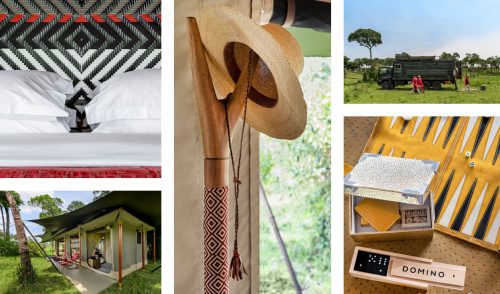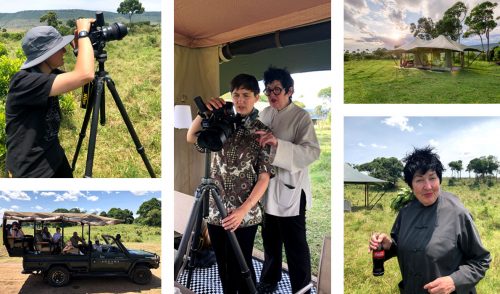
Last October, I found myself with an opportunity I never thought would happen, let alone in the midst of a pandemic. I had been commissioned to photograph the new Angama Safari Camp – a photographer’s dream job. I spent the days leading up to our departure constantly pinching myself to make sure it was real (something my COVID-19 test made sure of).
The new mobile and ‘Meccano-style’ (an early 20th century children’s building toy, like an Erector Set) tented camp packs completely flat and folds out from the back of a big van aptly named ‘Big Bertha’. It consists of 4 luxury guest tents – fully kitted-out with a walk-in wardrobe, en-suite bathroom (with a double head shower), and bedroom. The Guest Area, a lounge and dining tent, is where guests can relax as delicious meals and drinks are served and board games are deservedly won. And of course, the key element that makes Angama so incredibly special is the unique guest experiences like picnics under huge wild fig trees, romantic breakfasts in the long grass, and sundowners around the boma.

The best part about shooting Angama Safari Camp was being in the Maasai Mara daily. Our drives to and from the lodge were filled with an overwhelming assortment of wildlife, including the wildebeest migration, and dramatic scattered thunderstorms. The experience was, in short, out of this world. The romantic and age-old concept of a ‘bucket list’ finally made sense to my 20-something-year-old self. Ten days in the Mara went annoyingly fast and like with every really good movie or book when you eventually come to the end, you find a hunger to re-watch, re-read, return.


On the day we left the Mara it was raining. No, actually, it was storming. I imagine it was nature’s sense of humor, poking fun at my silly and irrational, but also ever-present, fear of turbulence. That’s not to say I’m afraid of flying per-say, I just don’t enjoy the concept of turbulence and the unnerving fact that all one can do is sit and soldier on through it.
We were informed – midway through our ‘Best Burger in the Mara’ – that the plane had arrived early and was awaiting our luggage. Looking up from my plate I saw the dark collective of storm clouds growing over the Mara plains. “Right, well best we get going then,” I thought, reassuring myself that we would be taking off before rainfall hit. Doris, Alice, and Azei (already dressed in rain coats) saw us off. It was a speedy yet somber drive to the landing strip. The team could feel how heavy our hearts were. None of us wanted to part ways – particularly not in these rushed circumstances.

As we turned a corner, we were met by the landing strip in front of us. All seemed perfectly in order except for the small detail that a plane wasn’t anywhere to be seen. In the midst of our shared bewilderment – and a couple of radio calls to the airport – Alice decided to drive us to the end of the strip in the event that the plane was parked out of sight. About a three-quarter way down the strip, large fat raindrops started to hit the windscreen. Azei and I were both hanging out of the vehicle attempting to pull down and tie the rain cover when overhead we heard the droning of an engine. “HOLD ON!” Alice shouted as she put her foot on the gas.
The plane cannot land if there is a safari vehicle on the strip, so mid- heavy rainfall and awkwardly trying to tie down a rain cover on a moving vehicle, we sped back to the start of the strip. I think the sheer absurdity and the culmination of events left us all in stitches. Mercifully, I now felt far removed from the fear of embarking on a tiny 6-seater plane.
With our bags loaded, we sat (soaking wet) and watched from the tiny plane’s windows, Alice, Doris, and Azei waving goodbye to us in the rain. The pilot proceeded with his checks before slowly starting the plane’s engines. The tiny propellers began spinning and I felt the familiar and unnecessary sensation of sweaty palms begin to take hold. But my eyes remained fixed on the faces of Alice, Doris, and Azei, until they became small familiar beacons of light amidst a sea of green.
My heart swelled, then sank. I realized in that minute that I hadn’t taken any photos of the beautiful faces I had been fortunate enough to meet. Furiously, I began flicking through my phone’s gallery longing to find something – a selfie at least – that would forever immortalise those smiles so I could take them with me, remember them, and share them with people back home.
You see, Kenya’s greatest currency is its people. And Angama is very rich.
So here I was, memory cards filled with photographs, but it didn’t matter how many wildebeest or sunsets I shot, they all felt like empty pictures to me now. I’ve asked them to send me some selfies whilst I count the days until I’ll be able to see them again.

Filed under: Inside Angama
Subscribe for Weekly Stories
Comments (2):
20 April 2021
She has been bitten by the Africa-bug! Once you go on safari in Africa, you want to return again and again and again......

Angama Safari Offers